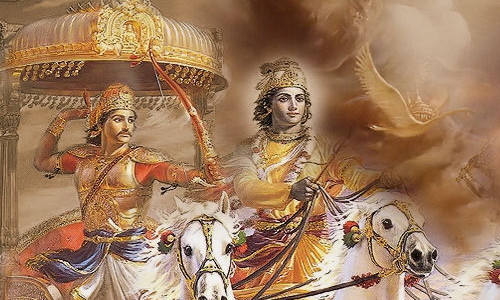The Bhagavad Gita was compiled by Sage Ved Vyaas over 5,000 years ago on Mokshadaa Ekadaasi in the month of Maarghsheersh (November-December). Shrimad Bhagavad Gita literally means ‘the Divine Song of God’ and is derived from one of the world’s longest epics, the Mahaabhaarat. It was revealed by Shri Krishna to Arjuna on the battlefield of Kurukshetra. This day is celebrated as Gita Jayanti (December 7, 2019).
Of the transcendental avataars of Vishnu, who are also representative of the spiritual evolution of human life, Shri Krishna represents the experience of ecstasy born of perfection. He is considered a vyuha avataar, instrumental in exercising cosmic functions and controlling the activities of living beings, as well as a purna avataar (full manifestation). In chapter 2, Shri Krishna tells Arjuna the three main reasons for the manifestation of the Supreme Being: “Whenever righteousness is on the decline and unrighteousness is on the ascendant, then I embody myself for the protection of the virtuous, for the extirpation of the evildoers and for establishing Dharma on firm footing. I am born from age to age.” His divine discourse, in Sanskrit, comprises 18 chapters and 700 shlokas (verses) and contains profound truths on life and liberation.
The battle between the two powerful armies is considered a metaphor of the inner battle to conquer the negative forces opposing the ultimate goal of realising the Supreme Lord. The practices that lead one to self-realisation, bhakti (devotion), karma (action) and gyaan (knowledge) yoga, are explained at great length by Shri Krishna. Yoga means ‘union’, specifically the union between the self (aatmaa) and the Supreme (Paramaatmaa). One of the practices emphasised throughout the text is the necessity of performing one’s duties. This is expressed quite clearly at the beginning of the very first chapter: “Dharma-kshetra kurukshetra”, the field of activity is the field of one’s duty. Shri Krishna provides guidelines for carrying out the many duties of our everyday lives. We are encouraged to honour the Lord and to serve the world, thereby repaying one’s debt to society. Some other subjects discussed in depth are: the nature of the soul, the sattvic (pious), rajasic (materialistic) and tamasic (inert) characteristics, the importance of selfless action, devotion to the form and formless God and the different forms of sacrifices and practices.
On the journey to moksha (liberation from the cycle of birth and death), the self-realised person is one whose entire life is devoted to God, and who inspires others by benevolence, purity of intent of actions, empathy and strength of character. Such an individual stimulates right action, encouraging personal uplift in others. He or she creates the spark of improvement, devotion to duty and the pursuit of a dharmic lifestyle. In the last chapter (chapter 18, verse 65), the Lord urges humans to surrender to Him in order to achieve self-realisation: “Give your mind to Me, be devoted to Me, worship Me and bow to Me. Doing so, you will come to Me alone, I truly promise you; for, you are exceptionally dear to Me.”
We should also resolve to strengthen our practice of Rishi Yagya by engaging ourselves in daily study of the Gita. In chapter 18, verses 70-71 state, “Whosoever studies this sacred dialogue of ours in the form of the Gita, by him too shall I be worshipped with Yajna of Knowledge; such is My word. The person who listens to the holy Gita with reverence, being free from malice, he too, liberated from sin, shall reach the propitious worlds of the virtuous.” An in-depth study of the Shrimad Bhagavad Gita can lead to some of the most profound truths and an experience of the omniscient, omnipotent God.
The Song Divine



